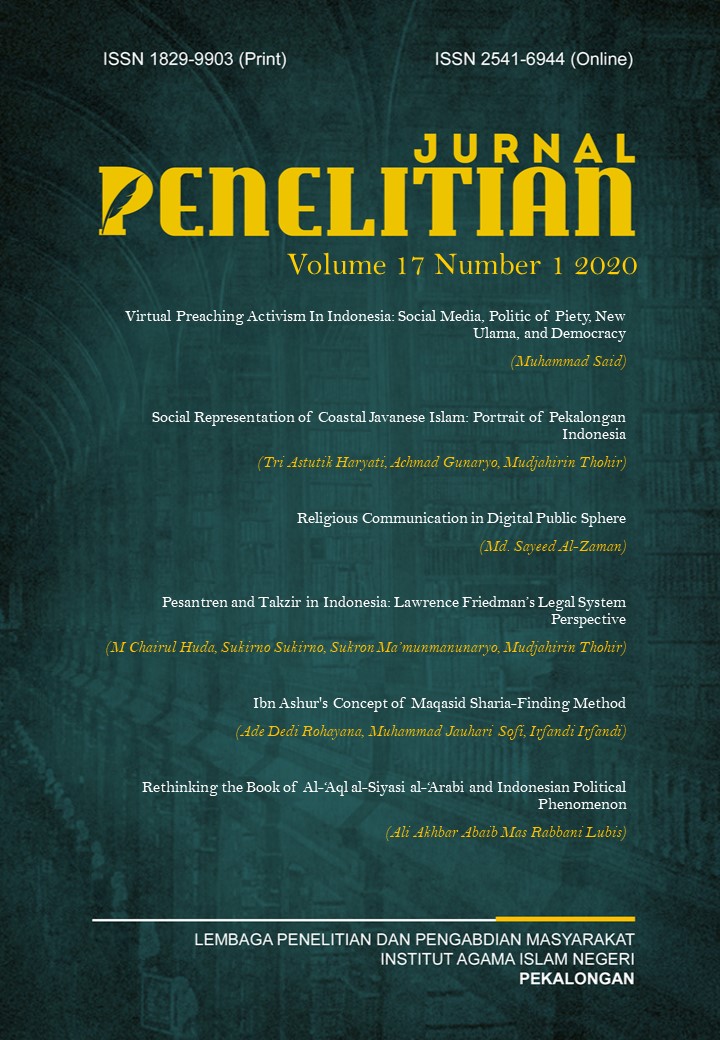Resilience of Muslim Families in the Pandemic Era: Indonesian Millennial Muslim Community's Response Against COVID-19
Main Article Content
Abstract
This paper aims to investigate the resilience of millennial Muslim families in Indonesia in the face of the
COVID-19 outbreak. The indicators examined were their resilience in gender partnerships, health and
security, economic conditions, social-psychological resilience, and social-cultural resilience. The sample of data
used in this study were 403 respondents. This research is a quantitative descriptive. The SPSS tool is used
to describe the percentage of respondents' answers. The results showed that the gender partnership, health
and safety, psychological social resilience, and socio-cultural resilience were in a quite good condition, but the
economic conditions of the millennial Muslim family were the opposite. Family science practitioners can
estimate millennial Muslim family behavior after the COVID-19 pandemic through this article. As for
academics, this article is used for further research by integrating millennial Muslim family endurance.
Empirically this research is useful to increase understanding of family resilience in the face of crisis.
Millennial Muslim family resilience is a relatively new phenomenon for practitioners and academics. This
research is a preliminary study that investigates the resilience of millennial Muslim families. Therefore, this
investigation will serve as an investigation of knowledge about the resilience of millennial Muslim families
when a virus outbreak occurs in Indonesia and the world.
Article Details

This work is licensed under a Creative Commons Attribution 4.0 International License.

This work is licensed under a Creative Commons Attribution 4.0 International License.
References
Ambebila, J. N., Daniel, E. O., Abiodun: O., Popoola, I. O., Moronkeji, S., Ojo, O. V., …
Adams, C. O. (2020). A Quantitative Study Exploring the Social Determinants of
Health in the North West Region of Cameroon. Journal of Family Medicine and Health
Care, 6(1), 8–14. https://doi.org/10.11648/j.jfmhc.20200601.12
Aswiyanto. (2019). Women, Reconciliation Right and Gender Justice in Islam Family Law.
Jurnal Penelitian, 16(2), 173–186. https://doi.org/10.28918/jupe.v16i2.2292
BPS. (2018). Statistik Gender Tematik 2018: Profil Generasi Milenial Indonesia. Jakarta: KPPPA.
Csikszentmihalyi, M. (2003). Good Business: Leadership. Flow and the Making of Meaning. New
York: Viking.
Fotiadis, A., Abdulrahman, K., & Spyridou, A. (2019). The mediating roles of psychological
autonomy, competence and relatedness on work-life balance and well-being. Front.
Psychol, 10(1267), 1–7. https://doi.org/10.3389/fpsyg.2019.01267
Gorbalenya, A. E. (2020). Severe acute respiratory syndrome -related coronavirus- The
species and its viruses, a statement of the Coronavirus Study Group. BioRxiv, 07(02).
https://doi.org/10.1101/2020.02.07.937862.
Hanson, S. M. H. (2001). Family health care nursing: An introducFamily health care nursing: Theory,
practice, and research (2nd ed). Philadelphia: F.A. Davis.
Holman, L., Stuart-fox, D., & Hauser, C. E. (2018). The gender gap in science: How long
until women are equally represented? PLOS Biology, 16(4), 1–20.
https://doi.org/10.1371/journal.pbio.2004956
Huang, Y.-H., Hammer, L. B., Neal, M. B., & Perrin, N. A. (2004). The Relationship
Between Work-to-Family Conflict and Family-to-Work Conflict: A Longitudinal
Study. Journal of Family and Economic Issues, 25, 79–100.
https://doi.org/10.1023/B:JEEI.0000016724.76936.a1
James, R. K., & Gilliland, B. E. (2012). Crisis intervention strategies. Belmont, CA: Cengage
Learning.
Kasdi, A. (2016). Filantropi Islam Untuk Pemberdayaan Ekonomi Umat (Model
Pemberdayaan ZISWAF di BMT Se-Kabupaten Demak). Jurnal Iqtishadia, 9(2), 227–
_______. (2019). Marriage Counseling as an Effort to Build a Sakinah Family; Model of
Fostering and Mentoring for Sakinah Families in Demak Regency. Jurnal Konseling
Religi, 10(1), 99–115. https://doi.org/http://dx.doi.org/10.21043/kr.v10i1.5500
Khotimah, K. (2018). Authority and Manifestation of God in The Narrative of Sufism.
Jurnal Penelitian, 15(2), 151–160. https://doi.org/10.28918/jupe.v15i2.1647
KPPPA, B. &. (2016). Katalog: Pembangunan Ketahanan Keluarga. Jakarta: KPPPA.
MacPhee, D., Lunkenheimer, E., & Riggs, N. (2015). Resilience as Regulation of
Developmental and Family Processes. Fam Relat, 64(1), 153–75.
https://doi.org/10.1111/fare.12100
Noor, N. M., Gandhi, A. D., Ishak, I., & Wok, S. (2012). Development of Indicators for
Family Well-Being in Malaysia, Social Indicators Research: An International and
Interdisciplinary. Journal for Quality-of-Life Measurement, Springer, 115(1), 279–318.
Patrão, A. L., Almeida, M.-C. C., Sheila Alvim, D. C., & Aquino, E. M. L. (2019). Health
behavior-related indicator of lifestyle: application in the ELSA-Brasil study. Glob
Health Promot, 26(4), 62‐ 69. https://doi.org/10.1177/1757975918763148
Patterson, J. M. (2002). Integrating Family Resilience and Family Stress Theory. Journal of
Marriage and Family, 64, 349–360. https://doi.org/10.1111/j.1741-3737.2002.00349.x
Pyöriä:, Ojala, S., Saari, T., & Järvinen, K.-M. (2017). The Millennial Generation: A New
Breed of Labour? SAGE Open. https://doi.org/10.1177/2158244017697158
Rowley, J. (2014). Designing and using research questionnaires. Management Research Review,
(3), 308–330. https://doi.org/10.1108/MRR-02-2013-0027
Rutter, M. (2006). Implications of resilience concepts for scientific understanding. The New
York Academy of Sciences, 109(4), 1–12. https://doi.org/10.1196/annals.1376.002
Windle, G. (2011). What is resilience? A review and concept analysis. Reviews in Clinical
Gerontology, 21(2), 152–169. https://doi.org/10.1017/S0959259810000420
Wood, W., & Eagly, A. H. . (2010). Gender. In S. T. Fiske, D. T. Gilbert, & G. (Eds. .
Lindzey (Eds.), Handbook of social psychology (pp. 629–667). John Wiley & Sons Inc.
https://doi.org/10.1002/9780470561119.socpsy001017
Zubrick, S. R., Williams, A. A., Silburn, S. R., & Vimpani, G. V. (2000). Indicators of social and
family functioning. Canberra: Department of Family and Community Services.

